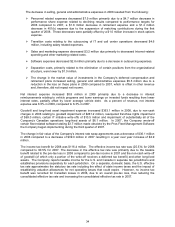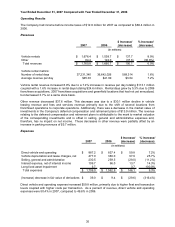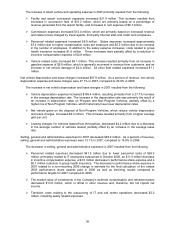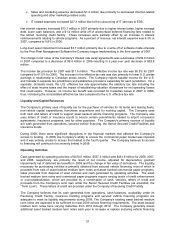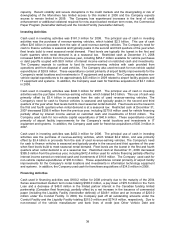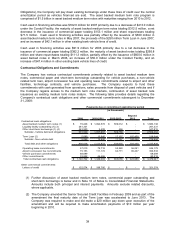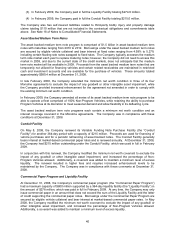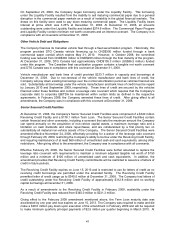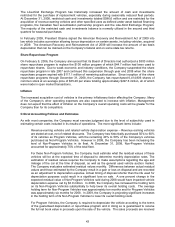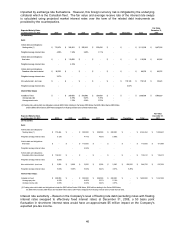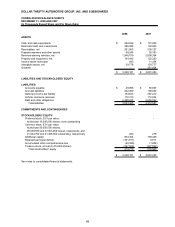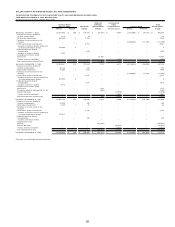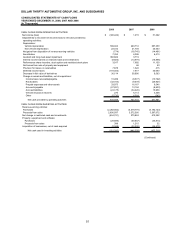Thrifty Car Rental 2008 Annual Report Download - page 45
Download and view the complete annual report
Please find page 45 of the 2008 Thrifty Car Rental annual report below. You can navigate through the pages in the report by either clicking on the pages listed below, or by using the keyword search tool below to find specific information within the annual report.The Like-Kind Exchange Program has historically increased the amount of cash and investments
restricted for the purchase of replacement vehicles, especially during seasonally reduced fleet periods.
At December 31, 2008, restricted cash and investments totaled $596.6 million and are restricted for the
acquisition of revenue-earning vehicles and other specified uses as defined under asset backed financing
programs, the Canadian fleet securitization partnership program and the Like-Kind Exchange Program.
The majority of the restricted cash and investments balance is normally utilized in the second and third
quarters for seasonal purchases.
In February 2009, President Obama signed the American Recovery and Reinvestment Act of 2009 into
law which includes a provision allowing bonus depreciation on certain assets, including vehicles, acquired
in 2009. The American Recovery and Reinvestment Act of 2009 will increase the amount of tax basis
depreciation that can be claimed on the Company’s federal and on some state tax returns.
Share Repurchase Program
On February 9, 2006, the Company announced that its Board of Directors had authorized a $300 million
share repurchase program to replace the $100 million program of which $44.7 million had been used to
repurchase shares. Due to weak economic and industry conditions, the Company suspended the share
repurchase program in late 2007 and continued this suspension through year end 2008 when the share
repurchase program expired with $117.1 million of remaining authorization. Since inception of the share
repurchase programs through December 31, 2008, the Company has repurchased 6,414,906 shares of
common stock at an average price of $35.48 per share totaling approximately $227.6 million, all of which
were made in open market transactions.
Inflation
The increased acquisition cost of vehicles is the primary inflationary factor affecting the Company. Many
of the Company’s other operating expenses are also expected to increase with inflation. Management
does not expect that the effect of inflation on the Company’s overall operating costs will be greater for the
Company than for its competitors.
Critical Accounting Policies and Estimates
As with most companies, the Company must exercise judgment due to the level of subjectivity used in
estimating certain costs included in its results of operations. The more significant items include:
Revenue-earning vehicles and related vehicle depreciation expense – Revenue earning vehicles
are stated at cost, net of related discounts. The Company has historically purchased 50% to 60%
of its vehicles as Program Vehicles, with the remaining 40% to 50% of the Company’s vehicles
purchased as Non-Program Vehicles. However in 2008, the Company has been increasing the
level of Non-Program Vehicles in its fleet. At December 31, 2008, Non-Program Vehicles
accounted for approximately 75% of the total fleet.
For these Non-Program Vehicles, the Company must estimate what the residual values of these
vehicles will be at the expected time of disposal to determine monthly depreciation rates. The
estimation of residual values requires the Company to make assumptions regarding the age and
mileage of the car at the time of disposal, as well as the general used vehicle auction market.
The Company evaluates estimated residual values monthly. Differences between actual residual
values and those estimated by the Company result in a gain or loss on disposal and are recorded
as an adjustment to depreciation expense. Actual timing of disposal shorter than the life used for
depreciation purposes could result in a significant loss on sale. A one percent change in the
expected residual value of Non-Program Vehicles sold during 2008 would have impacted vehicle
depreciation expense net by $3.9 million. In 2008, the Company has increased the holding term
on its Non-Program Vehicles substantially to help lower its overall holding costs. The average
holding term for Non-Program Vehicles was approximately ten months and for Program Vehicles
was approximately six months for 2008. In 2009, the Company is projecting significant increases
in the holding term of its Non-Program Vehicles to lower its overall holding costs.
For Program Vehicles, the Company is required to depreciate the vehicle according to the terms
of the guaranteed depreciation or repurchase program and in doing so is guaranteed to receive
the full net book value in proceeds upon the sale of the vehicle. The sales proceeds are received
43



